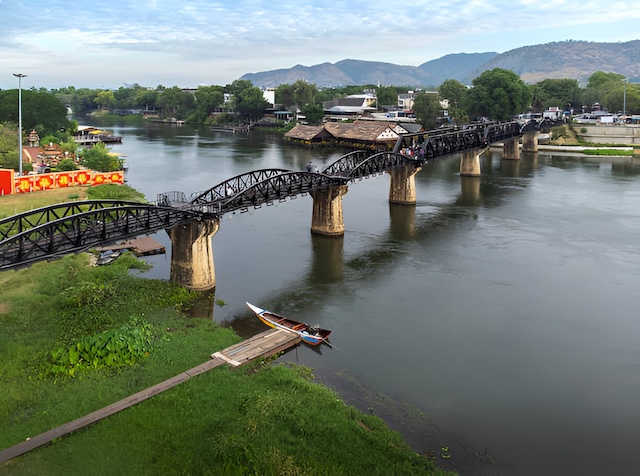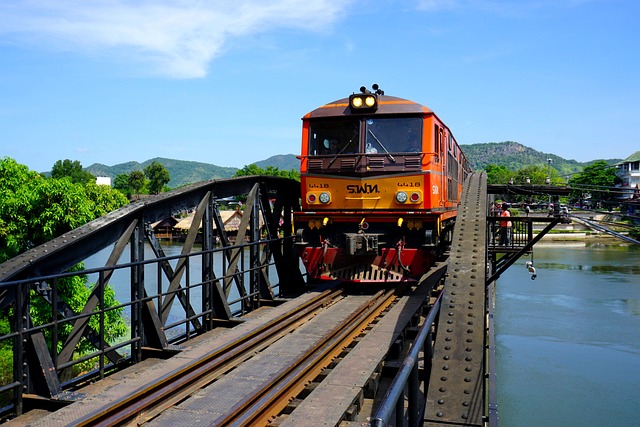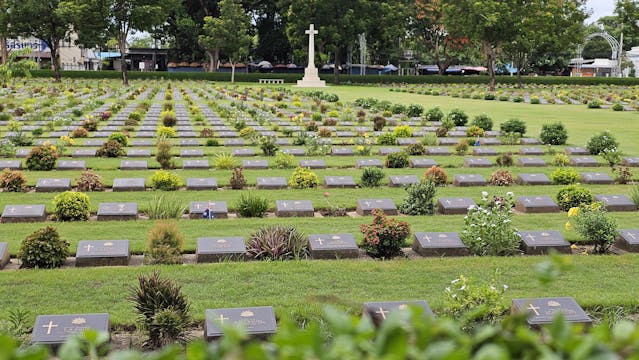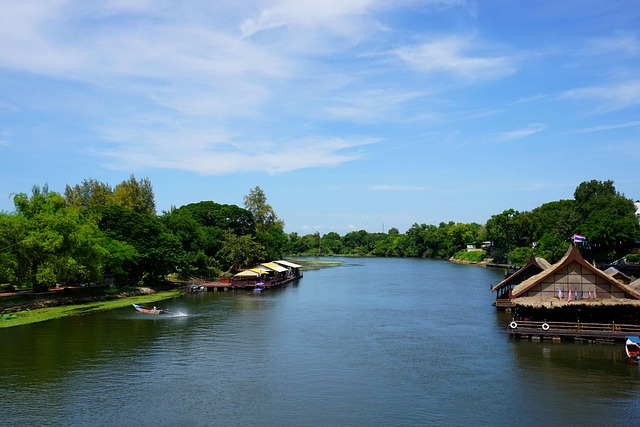Standing beside the Kwaï Yai River, the legendary bridge in Kanchanaburi is a place where echoes of the past blend with the rhythms of everyday Thai life. More than just a tourist stop, this site invites you to step into a story of resilience, remembrance, and natural beauty. Whether you’re drawn by its wartime legacy or the tranquil riverside atmosphere, your visit will be both moving and memorable.

Historical Origins
Wartime Construction and Human Cost
In the 1940s, Kanchanaburi became the backdrop for a dramatic wartime project. Under Japanese occupation, the railway bridge was created as part of a supply route to Burma (now Myanmar). The work was carried out by Allied POWs and Asian civilians, many of whom suffered from hunger, disease, and relentless labor. The toll was immense—historians estimate that more than 100,000 people lost their lives during the construction, leaving a legacy that still resonates throughout the region.
To better understand the broader historical events that shaped Thailand before, during, and after World War II, read our complete history of Thailand.
From Mae Klong to Global Icon
Originally built to cross the Mae Klong River, the bridge and the river were renamed “Kwaï Yai” in the 1960s, influenced by the worldwide success of the film. While the movie introduced this chapter of history to millions, it took many liberties with the facts. To truly understand the real story, a visit to Kanchanaburi offers far more insight than any screen adaptation. For further reading, see the Wikipedia article.
Echoes of the Past: Museums and Memories
A visit to the area is an opportunity to connect with the personal stories of those who lived through the construction of the railway. Local museums do more than display artifacts—they share first-hand accounts, survivor interviews, and interactive exhibits that help you understand both the suffering and the courage of those involved. These experiences bring history to life and encourage deeper reflection.
Visiting the Bridge Today
How to Get to Kanchanaburi
Reaching Kanchanaburi from Bangkok is simple and flexible. Whether you choose the scenic train ride, a comfortable bus, or a speedy minivan, you’ll pass through lush countryside before arriving at this riverside town. If you’re traveling during the rainy season, check out our article Thailand’s Rainy Season. For ideas on what to do when the weather isn’t ideal, see What to Do in Thailand When It Rains.
Getting there in detail: Trains depart from Bangkok’s Thonburi station, while buses leave from the Southern Bus Terminal (Sai Tai Mai). Minivans run from Victory Monument. Once you arrive, local tuk-tuks or taxis will bring you to the bridge area with ease.
What to See and Do Around the Bridge

Begin your exploration by crossing the bridge on foot, taking in the views and details that have stood the test of time. For a different perspective, board the tourist train that still runs along a portion of the historic railway. Don’t miss these nearby highlights:
- JEATH War Museum, where you can immerse yourself in the daily life of POWs
- The peaceful Kanchanaburi War Cemetery, a place for quiet contemplation
- Hellfire Pass Memorial, further along the railway, which offers a moving tribute to those who suffered
- Colorful local markets and family-run restaurants by the riverbank
More Experiences Nearby
- Take a boat trip on the River Kwai for a unique view of the landscape and riverside life.
- Swim beneath the waterfalls at the breathtaking Erawan National Park, located just a short drive from Kanchanaburi town.
- Wander the trails of other nearby parks and look out for local wildlife.
- Explore floating markets or cycle through nearby villages to discover authentic Thai culture.
- Rent a scooter for total freedom—see our scooter rental guide for tips.
Practical Information
You can visit the bridge at any hour, free of charge. Most museums are open from 9am to 5pm, with entrance fees typically between 40 and 100 baht. Tourist train tickets usually cost 100 to 200 baht, depending on seat and distance.
Riding the Death Railway
For many, the train ride to Nam Tok is a highlight of the trip. As you travel, you’ll see dense jungle, cross dramatic bridges, and stop at several sites of interest. Window seats are popular and worth booking ahead. While the train isn’t fully accessible, staff are generally helpful to those who need assistance.
Practical Tips for Travelers
Best Times to Visit
Based on my own experience, the most enjoyable moments in Kanchanaburi are found between November and February, when the air is fresh and the days are bright. If you prefer to explore without the crowds or the midday heat, consider heading out early or waiting until the late afternoon. This way, you can wander at your own pace and soak up the peaceful riverside atmosphere.
Festivals and Special Events
If your trip coincides with the Bridge Festival, which typically takes place as the year draws to a close, you’re in for a treat. During this unique event, the bridge becomes the stage for vibrant performances, moving ceremonies, and immersive reenactments that honor those who lived through its construction. The festival’s light shows and tributes create an unforgettable connection to the site’s past.
Where to Stay in Kanchanaburi
Whether you’re drawn to riverside luxury, a floating bungalow, or a simple guesthouse, Kanchanaburi offers something for every traveler. Personally, I love waking up near the river, where the sound of water and birds sets the tone for a tranquil day. Here are a few places to consider:
- Felix River Kwai Resort – Surrounded by lush gardens and right on the riverbank, this hotel is a favorite for its relaxing vibe.
- Noble Night Guesthouse – A friendly, affordable spot that’s just a short walk from the main sights.
- The FloatHouse River Kwai – For a stay you’ll never forget, try one of these unique floating villas.
Accessibility and Staying Safe
As you explore, keep in mind that the bridge doesn’t have guardrails along its entire length, so it’s important to watch your step and keep an eye on children. While some museums and attractions are accessible for travelers with reduced mobility, it’s a good idea to check ahead. Ramps are available at the main train station and museum entrances, but the bridge itself can be uneven. I recommend sturdy shoes and plenty of water, especially if you’re visiting during the hottest months. If you’re traveling with children, keep them close, especially on the bridge or near the tracks. For more tips on staying safe, see our Thailand scams to avoid guide.
Honoring the Memory of the Site

A visit to the Bridge on the River Kwai is as much about remembrance as it is about discovery. Out of respect for those commemorated here, choose modest clothing and maintain a thoughtful attitude, especially in cemeteries and museums. Reading survivor accounts or watching a documentary before your trip can help you appreciate the significance of what you’ll encounter.
The Bridge in Popular Culture
The Film and Its Lasting Impact
It was the Oscar-winning film by David Lean in 1957 that brought the bridge to global attention, with its whistled “Colonel Bogey March” still recognizable today. While the movie took many liberties with the actual events, it inspired generations of travelers to seek out the real history behind the legend.
Tourism and Legacy
Because of its cinematic fame and powerful history, Kanchanaburi is now a key destination for remembrance tourism in Thailand. Many tours include the bridge, often paired with trips to national parks and nearby waterfalls for a well-rounded experience.
Suggested Itineraries
- One day: Stroll the bridge, explore the JEATH Museum, pause at the war cemetery, and wander the local market.
- Two days: Take the train to Nam Tok, visit Hellfire Pass, and cool off at Sai Yok Noi waterfalls.
- Three days or more: Venture into Erawan National Park, enjoy a boat trip, and spend time in local villages for a deeper connection to the region.
If you’re looking for something different, consider a side trip to Lopburi, the City of Monkeys, another unforgettable Thai destination.
Other Historic Sites in Thailand
For those who love history, Ayutthaya and Sukhothai are must-sees. These ancient cities are famous for their impressive ruins and offer a fascinating look at Thailand’s rich heritage.
Conclusion: Where Past and Present Meet

Spending time at the Bridge on the River Kwai is more than just a stop on your travels—it’s a chance to reflect, learn, and appreciate both the beauty and the resilience of Kanchanaburi. For more inspiration, consider exploring lesser-known regions like Isaan or making your way to Lopburi.
FAQ – Bridge on the River Kwai
Where is this famous bridge located?
The bridge is in Kanchanaburi, about 2.5 hours west of Bangkok, Thailand.
Can you walk across the bridge?
Yes, you can cross on foot, but be mindful—some sections lack guardrails and the walkway can be uneven.
Are there still trains running?
Absolutely, both local and tourist trains continue to operate, especially to Nam Tok.
Is the bridge you see today the original?
Much of the bridge was rebuilt after the war, but the original pillars are still visible.
Do you need to book a guided tour?
Guided tours aren’t required, but they’re a great way to deepen your understanding of the site’s history. Tours are available in English and other languages.
Is the site suitable for families?
Yes, but keep a close eye on children, especially on the bridge and near the railway. There are plenty of family-friendly places to stay nearby.
Can you visit the bridge in a wheelchair?
Access is possible, though some parts may be difficult. Main museums offer adapted access—check ahead. Ramps are available at the main train station and museums.
Are there combined tours with other sites?
Yes, many tours include the bridge, Hellfire Pass, waterfalls, and Erawan National Park.
What souvenirs can you bring back from Kanchanaburi?
You’ll find handicrafts, books about the bridge, and local products at the markets near the site.
🔄 Last updated on June 25, 2025
